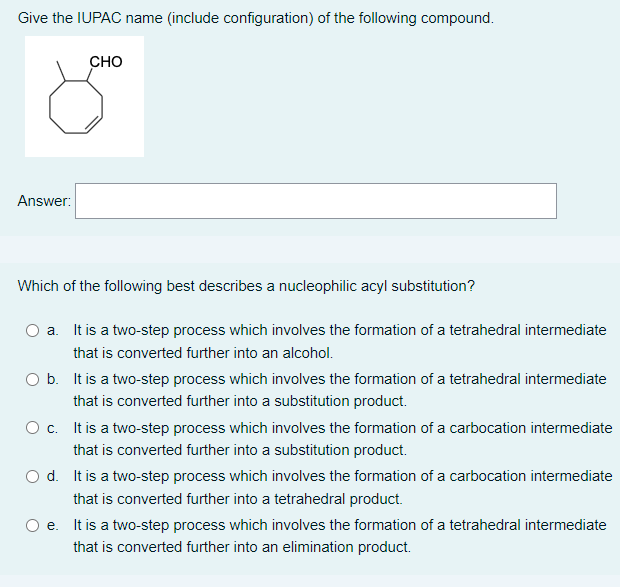Give the IUPAC name (include configuration) of the following compound. CHO Answer: Which of the following best describes a nucleophilic acyl substitution? a. It is a two-step process which involves the formation of a tetrahedral intermediate that is converted further into an alcohol. O b. It is a two-step process which involves the formation of a tetrahedral intermediate that is converted further into a substitution product. O c. It is a two-step process which involves the formation of a carbocation intermediate that is converted further into a substitution product. Od It is a two step process which involves the formation of a carbocation intermediate
Give the IUPAC name (include configuration) of the following compound. CHO Answer: Which of the following best describes a nucleophilic acyl substitution? a. It is a two-step process which involves the formation of a tetrahedral intermediate that is converted further into an alcohol. O b. It is a two-step process which involves the formation of a tetrahedral intermediate that is converted further into a substitution product. O c. It is a two-step process which involves the formation of a carbocation intermediate that is converted further into a substitution product. Od It is a two step process which involves the formation of a carbocation intermediate
Organic Chemistry
8th Edition
ISBN:9781305580350
Author:William H. Brown, Brent L. Iverson, Eric Anslyn, Christopher S. Foote
Publisher:William H. Brown, Brent L. Iverson, Eric Anslyn, Christopher S. Foote
Chapter10: Alcohols
Section: Chapter Questions
Problem 10.57P
Related questions
Question

Transcribed Image Text:Give the IUPAC name (include configuration) of the following compound.
CHO
Answer:
Which of the following best describes a nucleophilic acyl substitution?
a. It is a two-step process which involves the formation of a tetrahedral intermediate
that is converted further into an alcohol.
O b. It is a two-step process which involves the formation of a tetrahedral intermediate
that is converted further into a substitution product.
O c. It is a two-step process which involves the formation of a carbocation intermediate
that is converted further into a substitution product.
d. It is a two-step process which involves the formation of a carbocation intermediate
that is converted further into a tetrahedral product.
O e. It is a two-step process which involves the formation of a tetrahedral intermediate
that is converted further into an elimination product.
Expert Solution
This question has been solved!
Explore an expertly crafted, step-by-step solution for a thorough understanding of key concepts.
Step by step
Solved in 2 steps with 1 images

Knowledge Booster
Learn more about
Need a deep-dive on the concept behind this application? Look no further. Learn more about this topic, chemistry and related others by exploring similar questions and additional content below.Recommended textbooks for you

Organic Chemistry
Chemistry
ISBN:
9781305580350
Author:
William H. Brown, Brent L. Iverson, Eric Anslyn, Christopher S. Foote
Publisher:
Cengage Learning

Chemistry for Today: General, Organic, and Bioche…
Chemistry
ISBN:
9781305960060
Author:
Spencer L. Seager, Michael R. Slabaugh, Maren S. Hansen
Publisher:
Cengage Learning

Organic Chemistry
Chemistry
ISBN:
9781305580350
Author:
William H. Brown, Brent L. Iverson, Eric Anslyn, Christopher S. Foote
Publisher:
Cengage Learning

Chemistry for Today: General, Organic, and Bioche…
Chemistry
ISBN:
9781305960060
Author:
Spencer L. Seager, Michael R. Slabaugh, Maren S. Hansen
Publisher:
Cengage Learning